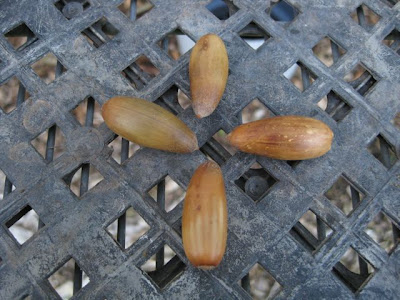They're nice to look at, sing wonderfully and eat insects.
No, we're not talking about the Dixie Chicks on a fad diet.
It's the gardener's best friends, a backyard filled with birds.
No, not Bill and Venus. Although they are accomplished gardeners/writers, the Birds, publishers of the Sacramento Vegetable Gardening blog, limit their insect consumption to whatever is inhabiting their harvested fruit. Or drink.
We're talking about the family inhabited by warm-blooded egg-laying vertebrates, characterized by feathers and forelimbs modified as wings.
 Yes, real birds will nibble on your cherries and grapes (that's why there's bird netting), but birds can help control the bad bug population in your garden, especially tomato hornworms, cabbage loopers and redhumped caterpillars.
Yes, real birds will nibble on your cherries and grapes (that's why there's bird netting), but birds can help control the bad bug population in your garden, especially tomato hornworms, cabbage loopers and redhumped caterpillars.
Birds also control the spread of weeds by eating the seeds of unwanted plants; bigger birds, such as owls and hawks, will swoop down and devour rodents.
Birds require little in return from you for their labors: trees and shrubs for shelter, perhaps some berry-filled plants (cotoneaster, pyracantha, toyon and more) and fresh water.
Birds aren't too particular about their watering sites. All they are looking for is a shallow pan, about two to three feet wide and no more than three inches deep, with sloping sides so they can ease their way in, placed in an area away from fence tops and foliage where they can keep an eye out for their main predator, Mr. Kitty.
A birdbath can be as elegant as a thousand dollar, terracotta fountain with a waterfall; or, as simple as an old metal garbage can lid placed on the ground.
Here are some tips for keeping the thirsty birds happy:
• Keep the birdbath water fresh and filled during hot weather. On freezing mornings, adding hot water can help break up the thin sheet of ice.
• Clean out birdbaths with a powerful jet of water from the hose; or, use a plastic scouring pad.
• Do not add chemicals, such as bleach, to control algae. Do not add antifreeze to keep ice from forming. If you must use bleach to clean an algae-filled birdbath, cover it with screening for a few hours to keep the birds away. Empty and rinse the birdbath after that and refill with fresh water.
• Birds are attracted by the sound of gently moving water. A simple drip irrigation mini-sprinkler installed adjacent to the birdbath will be a popular addition. Hanging a dripping bucket in a tree above a bird bath can attract birds, too.
• An exposed rock placed in the middle of birdbaths with straight edges give birds a place to land and check things out.
 • If the only area you can place a birdbath is near dense shrubbery, it is important to put the bath on a pedestal for their protection.
• If the only area you can place a birdbath is near dense shrubbery, it is important to put the bath on a pedestal for their protection.
• Then, sit back and enjoy the show!


















